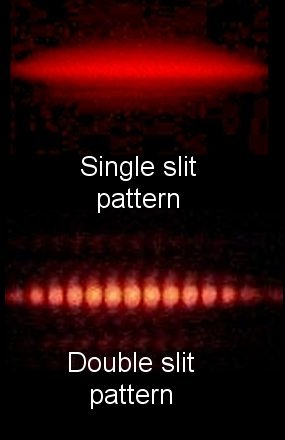Email to Abby, June 9, 2011
My crazy hypothesis:
When we look at the universe, we see matter and energy and gravity. With our understanding of the universe we expect matter to be in a specific place. So if we see particle P, and we are here H, then we expect to see P be x units from H. Graphically:
H xxx P
But when we look at the universe, P is farther from H than we expect, so:
H xxxx P
We use Dark Matter to explain the extra distance.
Some assumptions of mine that may not be true or accurate:
When a particle is in a superposition, it appears to be in two places.
Superposition is cumulative: in the gold ion, double-slit experiment, if the particle goes through a series of two sets of two slits, then the particle will look like four particles and not one or two.
Once a particle is observed, it cannot have superposition.
We cannot observe particles that are very far away from us; we can only observe the effects of that particle.
The question is why does P appear to be in location 2, instead of location 1?
H xxx P1P2
What if for particles that are very far away that they are all in superposition? So P appears to be in locations 1, 2, AND 3?
H xxx P1P2P3
And the “average” of these positions makes it appear it is location P2. Especially because we are not expecting the particle to be in superposition, we will only look for it to be in one place.
And since the particle appears to be farther away from us than we expect, then we think there is “red shift”.
If P is in superposition, why is it “biased” to appear to be farther away from us? Because for the positions that are closer to us, we have a higher probability of “observing” P, so the positions that are closer to us are biased against superposition, while the positions that are farther from us are biased for superposition. This is especially true for particles that are very far away.
The cumulative effect of all of these superpositions over time is to make matter look as if it is farther away from us than we expect.
So, this hypothesis attempts to 1) explain “red shift” (or the observation that matter is farther away from us than we expect) and 2) how particle physics interacts with relativity on a large scale.
Notes
Abby is a brilliant astrophysicist, and she spent many hours teaching me about physics. She also gave me books to help correct many of my misunderstandings. Because of her, I know that some of the things I wrote above are wrong.
What happens if we have two screens with double-slits?
I’ve just finished reading (on 15 July 2011) Feynman’s Six Easy Pieces and I have a little better understanding of physics and quantum mechanics. I’ve also learned a lot from Abby and I learned some from a lecture on Dark Matter that Abby took me to.

In the double-slit experiment, one of the ways to observe the particle going through the slits is to use a bright light. The particle will disturb the light as it goes through one slit or another. (It is a lot like the lasers used at stores to determine when someone walks in a store.) A light can only differentiate two points if the two points are farther apart than the wavelength of the light. So, if the wavelength of the light is longer than the distance between the two slits, then the light cannot observe which slit the particle went through.
I think the book implies that the math relating the wavelength of the light and the distance between the slits can be equated with the math of the uncertainty principle: ∆p*∆x ≥ ħ/2. If my idea about superposition is correct, I think that I am saying that the uncertainty principle is cumulative. So that over larger distances, the inequality because greater, e.g., ∆p*∆x ≥ 100000 * ħ. Maybe. Or maybe what I am saying is that gravity is increased when a particle is in superposition. Or maybe both.
Still, what happens when there are two screens, each with double slits, in series?
Gun → Screen one with two slits → Screen two with two slits → backdrop with detector
Without observers at either screen, will the uncertainty still be ∆p*∆x ≥ ħ/2? Or will it be some greater inequality?
And what happens when you put an observer at screen one but not screen two and an observer at screen two and not screen one and then both? I think the observer will only collapse the superposition at the screen it is observing.
Is it possible to use an observer at screen two to measure the inequality? The book seems to imply that by varying the wavelength of the light, we will know at which point the uncertainty kicks in. If the wavelength at which the uncertainty kicks in is greater than the distance between the slits on screen two, then the uncertainty is cumulative, right? But if there is no observer at screen one, then the particle is already in wave form, so what does it mean to observe it come through screen two? We would want to place the slits on screen two is places where an interference pattern would produce very different results for the slits on screen two. I mean, on screen two, slit one should be at a peak and slit two should be at a trough of probability from screen one. Meh. This sounds like crap.